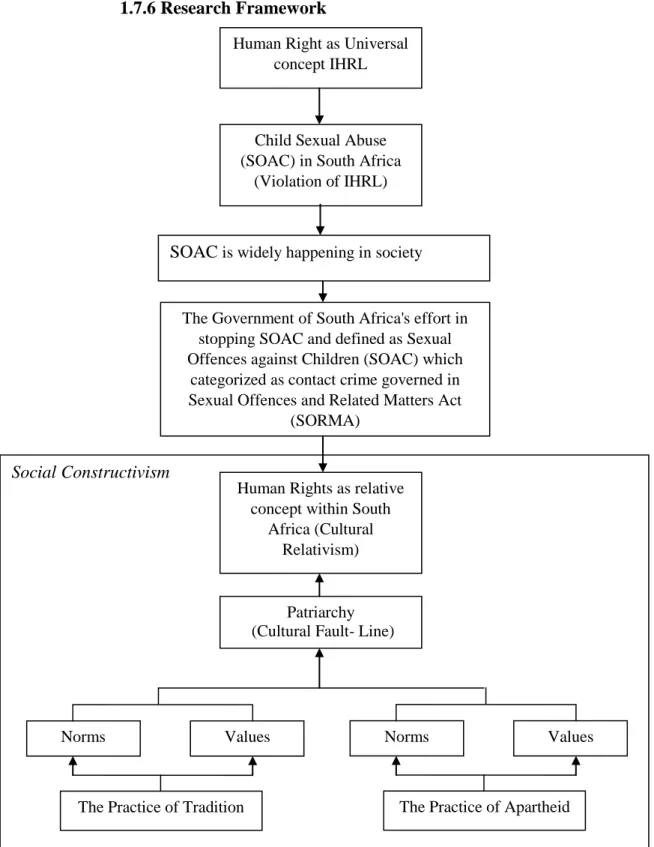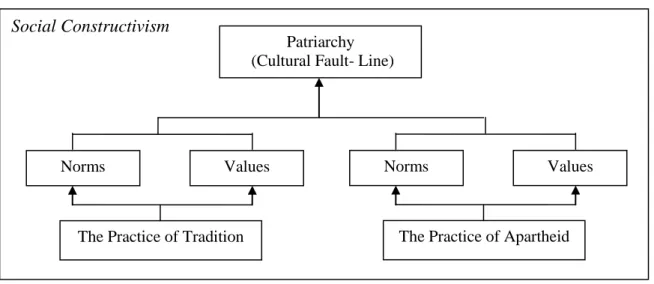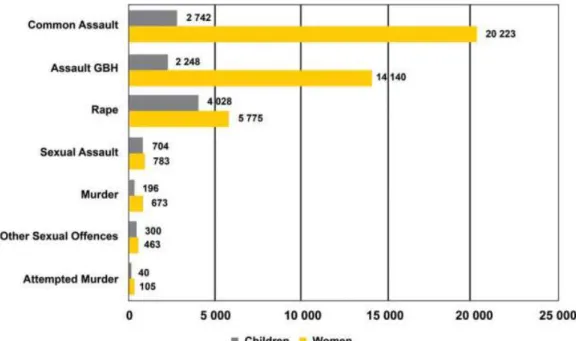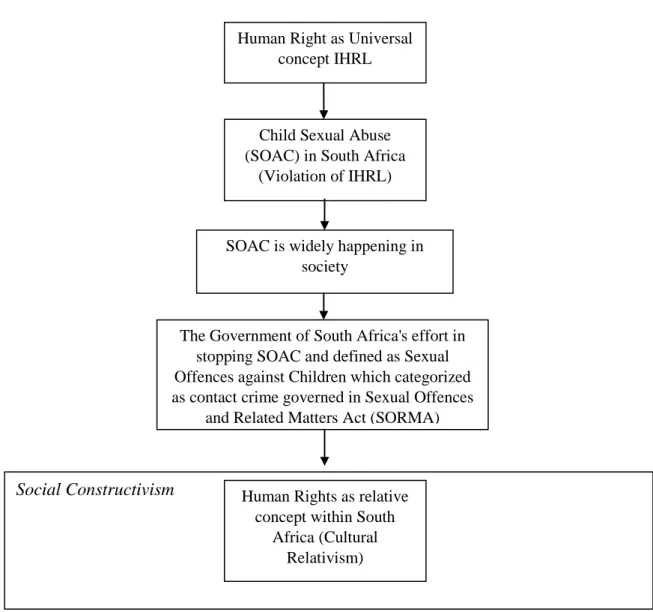Thirdly, in making this thesis, I would like to thank Miss Natasya Kusumawardani Prawiradinata and Mr. I want to say a big thank you to my coach and sister, Elisabteh Rompis (Lizl).
Background of Study
Furthermore, the Presidency of the Republic of South Africa has responded to the “UN Survey on Violence Against Children Questionnaire for Governments” made by the United Nations (Republic of South Africa, 2006). It is also in line with the rights of children enshrined in the Constitution.
Problem Identification
10 Source: Crime Situation in Republic of South Africa Twelve Months 01 April 2017 to 31 March 2018, South African Police Service. 11 This data was obtained from the South African Police Service Crime Situation in Republic of South Africa April 2017 to March 2018 (South African Police Service, 2018).

Statement of the Problem
Research Objective
Significance of Study
Scope and Limitation of the Study
Theoretical Framework
- Universalism
- Cultural Relativism
- Constructivism
- State's Responsibility to International Human Rights Law
- Patriarchy
- Research Framework
In Jack Donnelly's publication, "Cultural Relativism and Universal Human Rights", he defined cultural relativism in the context of international human rights. The cultural relativism will fit in with the thesis topic which opposes the universalism concept on human rights.

Research Methodology
Culture as a leading factor for SOAC in South Africa will be the main focus of this research. Figure I.7.5.2 (The Cycle of SOAC) showed that research found that there is a cycle in how SOAC is conducted widely in South Africa.
Literature Review
This therefore inspired the thesis's author on how the author analyzes the existence of SOAC in South Africa. In the case of SOAC, this chapter will help the author to analyze how SOAC can be put together in South Africa. This literature is in line with the thesis due to the explanation of patriarchy which helps the author to analyze the case of SOAK in South Africa.
This study is relevant to the thesis as it supports the author's analysis regarding SOAC in South Africa and the response of the South African government to this case. This book is important for the thesis as it covers almost all the reports and information related to SOAC in South Africa. Thus, it enhances the author's understanding in analyzing the case of SOAC in South Africa.
This book is important to the thesis because it contains the status of children in South Africa including case reports. 43 This book is important to the thesis because it gives a thorough understanding and data about SOAC in South Africa. This report supports 2011 data on crimes involving sexual offenses against children in South Africa.
Thesis Structure
In most of the GBV cases, it outlined the common roots of the problem, namely the dominance of man power over women and children in the social system (Gender Links, 2008). Children as a victim of violence rooted as a result of the patriarchal situation within the South African.
Child Sexual Abuse according to UN
The Committee on the Rights of the Child, the oversight body for the Convention, has encouraged states to review the age of consent if it is below 18 and to raise the level of protection for all children under 18.” Any sexual act , attempted solicitation of a sexual act, unwelcome sexual remarks or advances, or acts of human trafficking or otherwise directed against the sexuality of women, using coercion (i.e., psychological harassment, physical force, or threats of harm), by any person, regardless of relationship with the victim, in any setting, including, but not limited to, home and work.” (World Health Organization, 2002) 34;Sexual violence is defined as any sexual act, attempted sexual act, unwelcome sexual remarks or advances, or acts of trafficking, or otherwise directed against a person's sexuality by coercion, regardless of their relationship with the victim, in any setting, including but not limited to home and work." (World Health Organization, 2002).
48 Referring to the same source, SOAC is one of sexual assault as mentioned below. These include, for example: marital or dating rape, rape by strangers, systematic rape during armed conflict; unwelcome sexual advances or sexual harassment, including demanding sex in return for favours, sexual abuse of mentally or physically disabled people, sexual abuse of children, forced marriage or cohabitation, including marriage of children, denial of the right to use contraception or to adopt other measures to protect against sexually transmitted diseases, forced abortion, violence against women's sexual integrity, including female genital mutilation and mandatory virginity tests, forced prostitution and trafficking for sexual exploitation." (World Health Organization, This may include, but is not limited to: inducing or coercing a child to participate in any illegal sexual activity; the exploitative use of a child in prostitution or other illegal sexual practices; the exploitative use of children in pornographic performances and materials.” (World Health Organization).
We need to understand the forms of sexual victimization in relation to the matter of child sexual abuse. 34; 1. Without penetration: kissing and touching of intimate parts of the body by the offender or by the victim; 2. 34; Indecent exposure, voyeurism, confrontation with pornographic material, verbal sexual insinuations or harassment, sexual acts via electronic media (e.g. distribution of photos with nudity or pornographic films, verbal advances in chat rooms or similar)." (World Health Organization, n.d.) .
Child Sexual Abuse Violates IHRL
49 Optimus Study South Africa: Technical Report, Sexual victimization of children in South Africa Final report of the Optimus Foundation Study, sexual victimization can be distinguished as sexual victimization with physical contact and sexual victimization without physical contact. All are equal before the law and are entitled without any discrimination to equal protection of the law”(United Nations, n.d.). No one will be arbitrarily deprived of his life." (UN Human Rights Office of the High Commissioner, n.d.).
In addition, sexual abuse of children violates the Convention on the Rights of the Child (CRC) in which this convention binds state parties to protect and promote the fundamental rights of children. States Parties shall respect and ensure the rights set forth in this Convention to every child within their jurisdiction without discrimination of any kind, regardless of the child's or his or her parent's or legal guardian's race, colour, sex, language, religion , political or other opinion, national, ethnic or social origin, property, disability, birth or other status;. States Parties shall take all appropriate measures to ensure that the child is protected from all forms of discrimination or punishment based on the status, activities, expressed opinions or beliefs of the child's parents, legal guardians or family members. Nations, n.d.).
In all actions concerning children, whether carried out by public or private social welfare institutions, courts, administrative bodies or legislative bodies, the best interests of the child are paramount. The Contracting States shall, to the greatest extent possible, ensure the survival and development of the child.” (United Nations, n.d.). Almost all UN human rights conventions emphasize the protection of human rights, as people are equal and free from all discrimination.
Chapter Summary
International Human Rights
- The UN Convention on the Rights of the Child
- African Charter on the Rights and Welfare of the Child
- The United Nations Convention on the Elimination of all forms of
Constitution and Legislation
- The Constitution of Republic of South Africa Act, No 108 of 1996
- Children's Act 38 of 2005
- The Child Care Act, No 74 of 1983 (as amended)
- Criminal Law: Sexual Offences and Related Matters (SORMA)
- Domestic Violence Act, No 116 of 1998
- The Criminal Procedure Act 51 of 1977
- The Child Justice Act
Institutional and Constitutional Bodies Mandates
- The South African Human Right Commission (SAHRC)
- Department of Women, Children, and People with Disabilities (DWCPD)
- South African Police Service (SAPS)
- Department of Justice and Constitutional Development (DoJCD)
- National Prosecuting Authority (NPA)
Policies and Plan
- The National Development Plan (NDP)
- The Medium Term Strategic Framework (MTSF)
- The National Policy Guidelines for Sexual Offences
Programme and Strategies
- The Sixteenth Days of Activism
- The Victim Empowerment Programme (VEP)
- Thuthuzela Care Centres (TTCs)
- Family Violence, Children Protection, and Sexual Offences Unit (FCS)
Other International Obligations in regards to the Protection of Children
Civil Society and Others Programme & Strategies
- Project Ndabezitha
- Isolabantwana (Eye on the Child)
- Soul City Institute for Health and Development Communication (SC
7. 6 Sonke Gender Justice
- The Transform Education About Rape and Sexual Abuse (TEARS)
- Chapter Summary
- Contributing Factors to Sexual Offences against Children
- Age and Sex of the Child
- African Children Status
- Gender Inequality
- Masculinity Entitlements
- Poverty
- The Ideal Masculine Standards in South Africa society
- The Failure of SOAC Victim's Disclosure of the Case
- The Cycle of SOAC
- The Construction of Patriarchy in South Africa
- Tradition and Apartheid Constructed Patriarchy in South Africa
- Patriarchy as Cultural-Fault Lines
- Human Rights as Relativism Concept in South Africa
- Chapter Summary
These books focus primarily on case studies of gender-based violence (GBV) in South Africa, including some SOAC cases.
Furthermore, the establishment of the South African Human Rights Commission empowers the government to protect children's rights. 34; Girl children are particularly vulnerable to certain human rights violations, and therefore require additional protection." (United Nations Division for the Advancement of Women (DAW); UNICEF, 2006) Therefore, any discrimination and abuse against girls is part of the protection of CEDAW 34; CEDAW directly addresses the urgent need to improve the status of women and girls and emphasizes the need to eliminate all forms of discrimination against them." (United Nations Division for the Advancement of Women (DAW); UNICEF, 2006).
34;The Bill of Rights enshrined in the South African Constitution enumerates a number of provisions intended to ensure the protection, promotion and respect of the human rights of the people of South Africa.". 34;all people in South Africa are and feel safe." (Department of Planning, Monitoring and Evaluation and Department of Social Development, 2016). It also recognized that women and children are disproportionately vulnerable and more likely to become victims of sexual offences." (Department: Justice and Constitutional Development of the Republic of South Africa, 2012).
The Victim Empowerment Program (VEP) is "one of the core deliverables of the 1998 National Crime Prevention Strategy and is coordinated by DSD within the Justice, Crime Prevention and Security (JCPS) cluster." (Department of Planning, Monitoring, Evaluation and Department of Social Development, 2016) The VEP is a national program that operates in all provinces of South Africa. 34; The FCS has a mandate to police domestic violence, child protection and sexual offences.” (Department for Planning, Monitoring and Evaluation and Department for Social Development, 2016). 75 undergo a specialized eligibility check and do not have some of the basic requirements such as a driving licence.” (Department for Planning, Monitoring and Evaluation and Department for Social Development, 2016).
Volunteers receive support and guidance through The Welfare's strong infrastructure in South Africa and member organizations." (Gender Links, 2008). Violence prevention and the development of children's life skills are some of the key areas of focus.". In the practice of patriarchy, the terms masculinity are defined as "men's control over women." (Sigsworth, 2009) Because of this right, the perpetrators in most cases cannot experience the sexual violence as harmful or criminal (Sigsworth, 2009).
All this reinforced the glorification of brutality and male violence in South Africa's macho culture."




